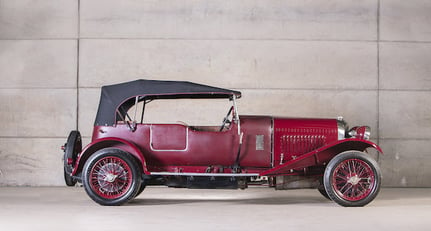1929 Bentley 4 1/2 Litre
-
Year of manufacture1929
-
Chassis numberMR 3399
-
Engine numberNX 3451
-
Lot number6
-
DriveLHD
-
ConditionUsed
-
Number of seats2
-
Location

-
Exterior colourOther
-
Drivetrain2wd
-
Fuel typePetrol
Description
1929 Bentley 4½-Litre Tourer
Coachwork by Vanden Plas
Registration no. DV 1262
Chassis no. MR 3399
Engine no. NX 3451
W O Bentley proudly debuted the new 3-litre car bearing his name on Stand 126 at the 1919 Olympia Motor Exhibition, the prototype engine having fired up for the first time just a few weeks earlier. In only mildly developed form, this was the model which was to become a legend in motor racing history and which, with its leather-strapped bonnet, classical radiator design and British Racing Green livery has become the archetypal vintage sports car.
Early success in the 1922 Isle of Man Tourist Trophy, when Bentleys finished second, fourth and fifth to take the Team Prize, led to the introduction of the TT Replica (later known as the Speed Model). However, by the middle of the decade the 3-Litre's competitiveness was on the wane and this, together with the fact that too many customers had been tempted to fit unsuitably heavy coachwork to the excellent 3-Litre chassis rather than accept the expense and complexity of Bentley's 6½-litre 'Silent Six', led to the introduction of the '4½'.
The new 4½-Litre model effectively employed the chassis, transmission and brakes of the 3-Litre, combined with an engine that was in essence two-thirds of the six-cylinder 6½-litre unit. Thus the new four-cylinder motor retained the six's 100x140mm bore/stroke and Bentley's familiar four-valves-per-cylinder fixed-'head architecture, but reverted to the front-end vertical camshaft drive of the 3-Litre. Bentley Motors lost no time in race-proving its new car. It is believed that the first prototype engine went into the 3-Litre chassis of the 1927 Le Mans practice car. Subsequently this same engine was fitted to the first production 4½-Litre chassis for that year's Grand Prix d'Endurance at the Sarthe circuit. The original 4½-Litre car, nicknamed by the team 'Old Mother Gun' and driven by Frank Clement and Leslie Callingham, promptly set the fastest race lap of 73.41mph before being eliminated in the infamous 'White House Crash' multiple pile-up.
The 4½-Litre was produced for four years, all but nine of the 665 cars made being built on the 3-Litre's 'Long Standard', 10' 10"-wheelbase chassis. Purchasers of the 4½-Litre model were, in common with those of all vintage-period Bentleys, free to specify their preferences from a very considerable range of mechanical and electrical equipment, in addition to whatever body style and coachbuilder might be required.
Clare Hay's authoritative work, Bentley, The Vintage Years, records that the car offered here - chassis number 'MR3399', fitted with engine number 'NX3451' - was completed in June 1929 fitted with four-seat tourer coachwork by London-based coachbuilder Vanden Plas. The original registration was 'DV 1262'. Vanden Plas had been founded in Belgium in the 19th Century, gaining a British offshoot when Warwick Wright obtained the UK rights to the name in 1913. After an uncertain start and numerous changes of ownership, the British firm went on to forge its not inconsiderable reputation by a most fortuitous alliance with Bentley, bodying some 700-or-so of the latter's chassis during the 1920s, including the Le Mans team cars.
This Bentley's first owner was one W F P Kelly. Copy correspondence on file from the next owner, Henri Girod-Eymery of Uzès, France, states that Kelly, a friend of his, had used the car, with long periods of idleness, up to 1962 before selling it. This letter, dated December 1968, states that Kelly had died 'a few years ago'. Reputedly, the engine had only one valve grinding at around 38,000 miles but nothing else. Girod-Eymery estimates the total mileage covered by that time (1968) as around 70,000. The rest of this correspondence concerns the despatch of major engine components (cylinder block, con-rods, valves, etc) to Messrs Hofmann & Burton of Henley-on-Thames for overhaul.
Prior to its sale to Girod-Eymery, the Bentley appears to have been registered to a museum, the Mecanique Ancienne Association de la Locomotion in Uzès, as evidenced by a registration document on file dated 30th August 1960. 'MR 3399' was subsequently loaned by an unnamed private collector to the Musée National de l'Automobile in Mulhouse, formerly the Schlumpf Museum Collection. Museum correspondence on file dated 31st August 1988 remarks that the Bentley is particularly 'noteworthy for its original mechanical condition'.
In February 1996 the car was offered for sale at a UK auction where it was purchased by Gordon Willey, and on 22nd March that year was reregistered with its original number, 'DV 1262'. The principal documentation on file appertaining to Gordon's period of ownership consists of an invoice dated 1st August 2001 from Chris Shenton Enngineering of Hanford, Staffordshire for overhauling the fuel and ignition systems plus various other works. The Bentley was then submitted for MoT testing and a certificate issued on 9th August 2001 at 63,167 miles (on file). More recently the car has been in storage at the premises of marque specialists P&A Wood. Offered with a V5C registration document, 'MR 3399' represents a rare opportunity for collectors to obtain a highly original Cricklewood Bentley that has had relatively few owners and spent much of its life on museum display.





















